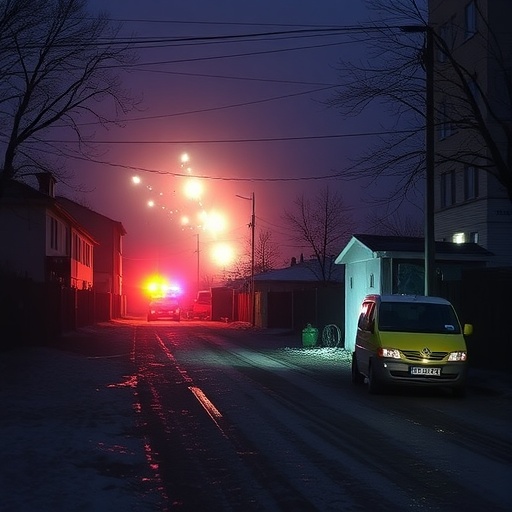Kyiv Overnight Russian Air Attack Leaves 14 Injured, Including Four Children: Urgent Plea for Advanced Air Defense in Ukraine
In the dead of night, the skies over Kyiv erupted in chaos as a relentless Russian attack targeted the Ukrainian capital, injuring 14 people—including four vulnerable children—and leaving residential neighborhoods scarred by destruction. This latest escalation in the ongoing conflict highlights the precarious state of Ukraine’s defenses against missile barrages, with officials sounding the alarm for immediate international support in bolstering air defense capabilities.
- Timeline of the Midnight Missile Onslaught in Kyiv
- Heartbreaking Stories: Children Injured in the Crossfire
- Devastation on the Ground: Residential Buildings Reduced to Rubble
- Officials Demand Patriots: The Push for Robust Air Defense Upgrades
- Strategic Ramifications: How This Attack Shapes Ukraine’s War Effort
The assault, which unfolded in the early hours of Wednesday, involved a barrage of missiles and drones that pierced through the night, striking multiple districts in Kyiv. Eyewitnesses described the terrifying sounds of explosions rattling windows and the acrid smell of smoke filling the air as families huddled in bomb shelters. Ukrainian emergency services responded swiftly, but the human cost was already evident: children injured among the casualties, underscoring the indiscriminate nature of the Russian attack on civilian areas.
Timeline of the Midnight Missile Onslaught in Kyiv
The Russian attack began around 2 a.m. local time, with air raid sirens blaring across Kyiv as radar systems detected incoming threats from the east. According to Ukraine’s Air Force, the assault comprised over 20 missiles of various types, including Iskander ballistic missiles and Kalibr cruise missiles launched from the Black Sea. Ukrainian forces managed to intercept approximately 70% of the projectiles using existing air defense systems, but several broke through, slamming into residential buildings in the Solomianskyi and Shevchenkivskyi districts.
Initial reports from the State Emergency Service of Ukraine detailed the sequence of events: the first impacts hit near apartment complexes at 2:15 a.m., followed by secondary explosions that shattered glass and ignited fires in nearby vehicles. By dawn, rescue teams had combed through the debris, pulling survivors from rubble-strewn streets. “We heard the boom, and then everything shook,” recounted Olena Kovalenko, a 35-year-old mother living in the affected area. “My two children were screaming; we didn’t know if the building would collapse on us.”
This incident marks the 15th major Russian attack on Kyiv in the past month alone, a pattern that has intensified since Russia’s full-scale invasion of Ukraine in February 2022. Data from the Kyiv International Institute for Sociology indicates that such strikes have disrupted daily life for over 80% of residents, forcing many into prolonged stays in underground metros turned makeshift shelters.
Heartbreaking Stories: Children Injured in the Crossfire
Among the 14 injured in the Russian attack, the plight of the four children injured has drawn international condemnation. The youngest victim, a 7-year-old boy named Artem, suffered shrapnel wounds to his legs while sleeping in his family’s third-floor apartment. Medical officials at Okhmatdyt Children’s Hospital reported that he underwent emergency surgery and is listed in stable condition, but the psychological trauma could linger for years.
Another child, 10-year-old Sofia, was struck by flying debris while evacuating with her parents. “She was so brave, holding her little brother’s hand as we ran,” her father, Mykhailo Petrenko, told reporters outside the hospital. The injuries range from concussions and lacerations to more severe cases requiring intensive care, with two of the children airlifted to specialized facilities in western Ukraine. Pediatric experts emphasize that such exposures to violence can lead to long-term issues like post-traumatic stress disorder, affecting an estimated 1.5 million children across Ukraine since the war began.
Humanitarian organizations, including UNICEF, have ramped up calls for protection of civilian areas. “Every child injured in these attacks is a failure of international safeguards,” said UNICEF Ukraine Representative Munir Mammadov in a statement. The incident has also spotlighted the vulnerability of Kyiv‘s densely populated suburbs, where over 2 million residents rely on outdated Soviet-era infrastructure ill-equipped for modern warfare.
To illustrate the broader impact, consider these statistics from the Ukrainian Ministry of Health: since January 2023, more than 500 children have been children injured or killed in aerial assaults nationwide, with Kyiv accounting for 15% of cases. Families like the Kovalenkos now face not just physical recovery but the emotional toll of disrupted schooling and constant fear, as Ukraine grapples with a humanitarian crisis exacerbated by the Russian attack.
Devastation on the Ground: Residential Buildings Reduced to Rubble
The physical scars from the Russian attack are stark, with at least five residential buildings in Kyiv sustaining significant damage. In the Solomianskyi district, a nine-story apartment block was partially collapsed, its facade torn open like a wound. Firefighters battled blazes that engulfed two vehicles and a nearby playground, while utility crews worked to restore power to over 1,000 affected households.
Damage assessments by local authorities reveal that the strikes caused an estimated $5 million in immediate repairs, not including long-term reconstruction costs. Photos circulating on social media show twisted metal, shattered windows, and families sifting through personal belongings amid the wreckage. “Our home is gone; we’ve lost everything,” lamented resident Iryna Sydorenko, whose ground-floor unit was directly hit.
Broader infrastructure impacts include disruptions to the city’s metro system, which serves as a vital evacuation route, and temporary blackouts that left entire blocks in darkness. The Russian attack also targeted non-residential sites, with shrapnel damaging a local school and a community center used for wartime aid distribution. In response, Ukraine‘s government has allocated emergency funds from its defense budget, but experts warn that repeated strikes are straining resources, diverting funds from other critical needs like medical supplies and winter preparations.
Environmental concerns have also emerged, as unexploded ordnance from the missiles poses ongoing risks. Demining teams from the Ukrainian State Emergency Service have already neutralized three such devices in the vicinity, highlighting the hidden dangers lingering after the Russian attack on Kyiv.
Officials Demand Patriots: The Push for Robust Air Defense Upgrades
Ukrainian leaders wasted no time in linking the Russian attack to gaps in air defense, with President Volodymyr Zelenskyy addressing the nation in a morning briefing. “This barbaric assault on Kyiv proves once again why we need more Patriot systems and other advanced air defense now,” Zelenskyy stated, his voice laced with urgency. “Every delayed delivery costs lives—children injured, homes destroyed, futures shattered.”
The Patriot missile defense system, a U.S.-made technology credited with intercepting over 90% of threats in previous engagements, has become a symbol of Ukraine‘s survival. Currently, Ukraine operates only a handful of these batteries, provided by Western allies since 2023, covering major cities like Kyiv but leaving vast territories exposed. Defense Minister Rustem Umerov elaborated in a press conference: “Our current air defense arsenal intercepted most missiles last night, but the ones that got through caused this tragedy. We require at least 25 Patriot systems to fully protect our skies.”
International responses have been mixed but supportive. U.S. Secretary of State Antony Blinken reiterated commitments to air defense aid during a NATO meeting, announcing an additional $1 billion package that includes interceptor missiles. However, delays in deliveries—attributed to production backlogs and political debates in donor countries—have frustrated Ukrainian officials. “Ukraine cannot wait while Russia reams its arsenal,” noted Andriy Yermak, head of the Presidential Office, in an op-ed for a European news outlet.
Experts from the Atlantic Council point out that enhancing air defense could reduce civilian casualties by up to 80%, based on simulations of full Patriot deployment. Training programs for Ukrainian operators, ongoing in Germany and Poland, are accelerating, but the window for implementation narrows with each Russian attack.
The call for air defense extends beyond Patriots to integrated systems like NASAMS from Norway and IRIS-T from Germany, which could create a layered shield over Kyiv and other cities. Advocacy groups are lobbying for expedited transfers, citing the children injured in this latest incident as a moral imperative.
Strategic Ramifications: How This Attack Shapes Ukraine’s War Effort
As Ukraine tallies the costs of the Russian attack on Kyiv, the incident reverberates through military and diplomatic channels, potentially altering the trajectory of the conflict. Analysts suggest that Russia’s focus on urban centers like Kyiv aims to erode civilian morale and pressure Kyiv into concessions, a tactic reminiscent of the 2022 siege attempts. Yet, such strikes often backfire, galvanizing domestic resolve and international sympathy.
Looking ahead, the push for advanced air defense could accelerate Western aid packages, especially with upcoming summits like the NATO summit in Washington. Ukrainian diplomats are preparing proposals for a “Sky Shield Initiative,” seeking commitments from 20+ nations to pool resources for air defense coverage across Ukraine. Success here might deter future Russian attacks, protecting not just Kyiv but the nation’s industrial heartland.
On the ground, community resilience shines through: volunteers in Kyiv are organizing relief drives for the children injured and displaced families, while tech innovators develop drone-detection apps to supplement official warnings. The long-term vision includes rebuilding with fortified designs, integrating air defense into urban planning to safeguard future generations.
Ultimately, this Russian attack serves as a stark reminder of the stakes in Ukraine‘s fight for sovereignty. With air defense enhancements on the horizon, there is cautious optimism that the skies over Kyiv could soon be safer, preventing more children injured and fostering a path toward peace amid the turmoil.









